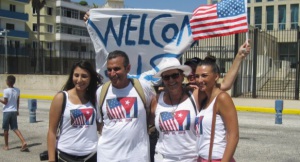Reinaldo Cruz, native of Manzanillo with permanent address in the Havana neighbourhood of El Calvario, was deported to Cuba in 2011. Today, he spends all day drunk on the beach, surviving only thanks to the money people give him, occasional thefts or by narrating his misdeeds from the time he lived in Orlando.
Another deportee, Bernardo Muñoz, also unemployed, with the same tramp-like look, struggles in Jaimanita. “I used to fly like an arrow from the United States in my speedboat to pick up people for ten thousand bucks… And now, look at me, not even a penny to buy bread.”

He was captured by border guards during one of his raids and sentenced to ten years in prison. Due to poor diet and beatings in the prisons of Pre de Villa Clara, Manacas and Combinado del Este, he lost teeth, hair, and got arthritis. Despite all these calamities he declares to love Fidel Castro, calling him “mi padre”: my father.
“Daddy shouldn’t trust anyone, not even Raúl. He can only rely on the Five; they are screened and can be trusted. But apart from them, nobody!” says Bernardo as he leaves our conversation aside when he sees a couple coming to the beach. He checks the scene, approaches them stealthily and begins to socialize, looking for profit.
These and similar scenes take place throughout the island with individuals who had lived in the United States and were deported to Cuba for various reasons. In 1984, under the Reagan administration, an agreement to return 2,746 so-called “excludable” Cubans was signed. Many of them had participated in the riots in Fort Chaffee, Arkansas, in 1980, and Atlanta, Georgia, and Oakdale, Louisiana, in 1987.
1,999 from them have already been deported to Cuba. In 2005, about 700 Mariel Cubans who remained incarcerated despite having served their sentences had to be released after the US Supreme Court ruling which forbade indefinite detentions of people who could not be returned to their country of origin.
“It’s a challenge to have an excludable in the neighbourhood,” says Diosdado, member of the Communist Party of the municipality of Arroyo Naranjo, Los Pinos District. “We must give him twice as attention than to any other case; we have to reintegrate him to society, assimilate him, show him that the revolution is benevolent, but watch his every step because he is a potential criminal.”
Two excludables from Juanelo, Cachulo and El Meta, were taken from prison in 1980 while serving penalties, and sent to the United States via the port of Mariel. They had gotten involved in drug trafficking. “But everything was made up; we spent ten years in prison in Atlanta, until they sent us back here.”
Cachulo ensures that he can return at any time, because his two children are American and can claim it. His buddy reminds him that “for a deportee it is almost impossible to return to the United States.”
Emilio, excludable from Santa Fe, is despised even by his family. When he gets drunk, he burns official documents: ration card, identity cards, home ownership documents… He inflicted himself sixteen stab wounds, the last one in the tongue.
In 2014, Cuba refused to receive 878 persons found “excludable” by the United States. In the first five months of 2015, 400 of them have already been rejected. This denial to receive “sons of the country” may be caused by the high number of complaints in the neighbourhoods due to the antisocial attitude of these persons.
Currently there are 34,525 Cubans in the USA with final order of deportation, 110 of which remain under arrest for security reasons. The remaining 34,415 are released and must report regularly to the immigration authorities. But these figures could be higher due to the growing number of Cuban nationals serving sentences for serious crimes, which are sent immediately before an immigration judge to rule on their deportation.
There is no indication that the issue of deportable Cubans were at the table in meetings held in Havana last January and in Washington on February 27. No massive deportations of Cubans are likely to happen due to the implications this action would have on thousands of people with no family ties on the island, and the difficulties with their reintegration into society.

Leave a comment